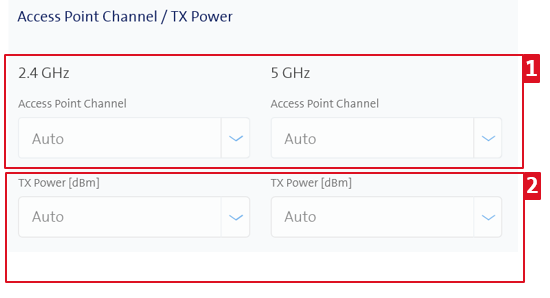WLAN: Expanding settings (channel and TX power)
Configure access point channel and transmit power
- You can configure the access point channel and the transmit power of the access point in the dashboard.
- You can find these functions under the corresponding access point at a location in the dashboard.
Important: These configurations only affect the selected access point and not all access points at a location.
- You can set a fixed channel or leave the WLAN channel setting on Auto.
- The access point then automatically selects a suitable channel.
- You can increase the WLAN signal strength by setting a fixed channel.
- TX power is a measure of how strongly the signal is transmitted.
- The best setting is the minimum level required to maintain the signal at the boundaries of the Wi-Fi location.

Configure the frequency band and data rates
- In the dashboard, you can configure the frequency band and data rates and switch the DFS channels on or off.
- You can find these functions at the respective location under Access Point in the dashboard.
Important: These configurations apply to all access points/SSIDs in one location and not just one access point/SSSID.
- DFS is a Wi-Fi feature that allows WLANs to use 5 GHz frequencies, which are usually reserved for radar.
- A major advantage of using DFS channels is that they use underserved frequencies to increase the number of Wi-Fi channels available.
- DFS can be deactivated if, for example, problems occur with nearby airport radars and a customer’s Wi-Fi performance is disrupted.
- Low density mode – The modulation rate set is optimised for a single access point with a low density of access points at the location.
- High density mode – The modulation rate set is optimised for a high number of access points at one location.
- Frequency band – By default, both frequencies (2.4 GHz / 5 GHz) are active, but it is only possible to activate one of them (2.4 GHz or 5 GHz).
